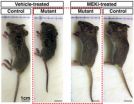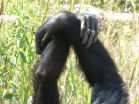(Press-News.org) Aplastic anaemia is characterised by a reduction in the number of the bone marrow cells that go on to form the different cell types present in blood (essentially red blood cells, white blood cells and platelets). In most cases, the causes of the disorder are hard to determine, but some patients have been found to have genetic alterations leading to a shortening of their telomeres (the end regions of chromosomes that protect and stabilise DNA).
A team at the Spanish National Cancer Research Centre (CNIO) led by María Blasco has successfully created a transgenic mouse model that simulates the disease in humans. And its study has allowed them to demonstrate the process linking telomere impairment with the condition. Their results are published today in the online edition of the journal Blood.
Telomeres and stem cells
Telomeres consist of a repetitive DNA sequence bound to a series of proteins, including Trf1, which guard them from degradation and/or damage. Using transgenic techniques, Blasco's team have managed to eliminate the Trf1 protein from mouse bone marrow, in order to explore its role in the tissue's function.
They found that when Trf1 is eliminated, the mice develop exactly the same symptoms as aplastic anaemia sufferers: bone marrow failure with the corresponding pancytopenia (a reduction in the number of red and white blood cells, as well as platelets). Also, the authors have shown for the first time that the absence of this protein causes a shortening of the telomeres of blood cell-producing stem cells which leads, in turn, to the progressive stress-induced death of the remaining stem cells in the tissue and, eventually, the death of the animal.
This discovery establishes the molecular bases of certain genetic variants of aplastic anaemia and opens a new line of attack via Trf1 to prevent the telomere shortening and cell death that trigger the disease. "We have generated an animal model for aplastic anaemia associated with short telomeres that may aid in the design and testing of new therapeutic strategies," confirms Blasco. These findings may also offer insights into other processes linked to telomere length, such as ageing and cancer.
### END
A CNIO team creates a unique mouse model for the study of aplastic anaemia
Maria Blasco's Telomere and Telomerase Group at the CNIO elucidates the link between telomeres and bone marrow failure in aplastic anaemia by means of a new mouse model
2012-08-29
ELSE PRESS RELEASES FROM THIS DATE:
Oversized fat droplets: Too much of a good thing
2012-08-29
KANSAS CITY, MO—As the national waistline expands, so do pools of intra-cellular fat known as lipid droplets. Although most of us wish our lipid droplets would vanish, they represent a cellular paradox: on the one hand droplets play beneficial roles by corralling fat into non-toxic organelles. On the other, oversized lipid droplets are associated with obesity and its associated health hazards.
Until recently researchers understood little about factors that regulate lipid droplet size. Now, a study from the Stowers Institute of Medical Research published in an upcoming ...
Climate change could increase levels of avian influenza in wild birds
2012-08-29
ANN ARBOR, Mich.—Rising sea levels, melting glaciers, more intense rainstorms and more frequent heat waves are among the planetary woes that may come to mind when climate change is mentioned. Now, two University of Michigan researchers say an increased risk of avian influenza transmission in wild birds can be added to the list.
Population ecologists Pejman Rohani and Victoria Brown used a mathematical model to explore the consequences of altered interactions between an important species of migratory shorebird and horseshoe crabs at Delaware Bay as a result of climate ...
ESC analysis reveals arrhythmia treatment gaps between Eastern and Western Europe
2012-08-29
The analysis was conducted using five editions of the EHRA White Book, which is produced by the European Heart Rhythm Association (EHRA), a registered branch of the European Society of Cardiology (ESC).
The EHRA White Book reports on the current status of arrhythmia treatments in the 54 ESC member countries and has been published every year since 2008. Data is primarily provided by the national cardiology societies and working groups of cardiac pacing and electrophysiology of each ESC country. Prospective data is collected on catheter ablation and on implantation of cardiovascular ...
TAVI restricted to very old or very sick patients
2012-08-29
The registry is part of the European Society of Cardiology (ESC) EURObservational Research Programme (EORP) of surveys and registries.
Today's presentation reveals current usage of the most modern TAVI valves and catheters in Europe, and compares indications, techniques and outcomes between different countries. "TAVI is a new technology which has been introduced in Europe but many question marks remain on which patients are most suitable," said Professor Di Mario. "We set up this registry because it was important to have a clear picture of clinical practice in Europe. ...
Added benefit of fampridine is not proven
2012-08-29
Fampridine (trade name Fampyra®) has been approved in Germany since July 2011 for adult patients suffering from a higher grade walking disability (grades 4 to 7 on the EDSS disability status scale), as a result of multiple sclerosis (MS). The German Institute for Quality and Efficiency in Health Care (IQWiG) has assessed the added benefit of the drug pursuant to the Act on the Reform of the Market for Medicinal Products (AMNOG). According to the findings, there is no proof of added benefit, as the manufacturer's dossier contains no evaluable study data for the comparison ...
Could a cancer drug potentially prevent learning disabilities in some kids?
2012-08-29
ANN ARBOR, Mich. — A drug originally developed to stop cancerous tumors may hold the potential to prevent abnormal brain cell growth and learning disabilities in some children, if they can be diagnosed early enough, a new animal study suggests.
The surprising finding sets the stage for more research on how anti-tumor medication might be used to protect the developing brains of young children with the genetic disease neurofibromatosis 1 -- and other diseases affecting the same cellular signaling pathway.
The findings, made in mice, are reported in the journal Cell ...
Belimumab for lupus erythematosus: Added benefit not proven
2012-08-29
Belimumab (trade name Benlysta ®) has been approved since July 2011 as an add-on therapy for adult patients with the autoimmune disease systemic lupus erythematosus (SLE). This monoclonal antibody is only considered as treatment when the disease is still active in spite of standard therapy. The German Institute for Quality and Efficiency in Health Care (IQWiG) has now examined the added benefit of this drug pursuant to the Act on the Reform of the Market for Medicinal Products (AMNOG).
According to the findings, there is no proof that belimumab provides added benefit ...
Mount Sinai researchers solve mystery surrounding the death of two sisters nearly 50 years ago
2012-08-29
Researchers at Mount Sinai School of Medicine have identified the genetic cause of a rare and fatal bone disease by studying frozen skin cells that were taken from a child with the condition almost fifty years ago. Their study, which details how the MT1-MMP gene leads to the disease known as Winchester syndrome, appears in the August 23, 2012 online edition of The American Journal of Human Genetics.
In 1969, Patricia Winchester, MD, a pediatric radiologist in New York City, was asked to diagnose two young sisters who were losing bone in their hands and feet, developing ...
Biomass characterization technology research highlighted in Industrial Biotechnology journal
2012-08-29
New Rochelle, NY, August 29, 2012--Biomass recalcitrance--the problem of how to break down complex plant-based cellulosic feedstock into sugars that can be fermented to produce sustainable biofuels and other renewable biobased products—can be overcome through improved methods of biomass characterization. IB IN-DEPTH, a collection of articles from leading research laboratories describing advanced tools and techniques for analyzing the chemistry, structure, and interaction of biomass components, is published in Industrial Biotechnology, a peer-reviewed journal from Mary Ann ...
Chimpanzees create social traditions
2012-08-29
A research collaboration between the Gonzaga University and the Max Planck Institute shows that the way in which chimpanzees groom each other depends on the community to which they belong. Specifically, it is the unique handclasp grooming behaviour that reveals this local difference.
The specific behaviour that the researchers focused on was the 'grooming handclasp', a behaviour where two chimpanzees clasp onto each other's arms, raise those arms up in the air, and groom each other with their free arm. This behaviour has only been observed in some chimpanzee populations. ...
LAST 30 PRESS RELEASES:
Making lighter work of calculating fluid and heat flow
Normalizing blood sugar can halve heart attack risk
Lowering blood sugar cuts heart attack risk in people with prediabetes
Study links genetic variants to risk of blinding eye disease in premature infants
Non-opioid ‘pain sponge’ therapy halts cartilage degeneration and relieves chronic pain
AI can pick up cultural values by mimicking how kids learn
China’s ecological redlines offer fast track to 30 x 30 global conservation goal
Invisible indoor threats: emerging household contaminants and their growing risks to human health
Adding antibody treatment to chemo boosts outcomes for children with rare cancer
Germline pathogenic variants among women without a history of breast cancer
Tanning beds triple melanoma risk, potentially causing broad DNA damage
Unique bond identified as key to viral infection speed
Indoor tanning makes youthful skin much older on a genetic level
Mouse model sheds new light on the causes and potential solutions to human GI problems linked to muscular dystrophy
The Journal of Nuclear Medicine ahead-of-print tip sheet: December 12, 2025
Smarter tools for peering into the microscopic world
Applications open for funding to conduct research in the Kinsey Institute archives
Global measure underestimates the severity of food insecurity
Child survivors of critical illness are missing out on timely follow up care
Risk-based vs annual breast cancer screening / the WISDOM randomized clinical trial
University of Toronto launches Electric Vehicle Innovation Ontario to accelerate advanced EV technologies and build Canada’s innovation advantage
Early relapse predicts poor outcomes in aggressive blood cancer
American College of Lifestyle Medicine applauds two CMS models aligned with lifestyle medicine practice and reimbursement
Clinical trial finds cannabis use not a barrier to quitting nicotine vaping
Supplemental nutrition assistance program policies and food insecurity
Switching immune cells to “night mode” could limit damage after a heart attack, study suggests
URI-based Global RIghts Project report spotlights continued troubling trends in worldwide inhumane treatment
Neutrophils are less aggressive at night, explaining why nighttime heart attacks cause less damage than daytime events
Menopausal hormone therapy may not pose breast cancer risk for women with BRCA mutations
Mobile health tool may improve quality of life for adolescent and young adult breast cancer survivors
[Press-News.org] A CNIO team creates a unique mouse model for the study of aplastic anaemiaMaria Blasco's Telomere and Telomerase Group at the CNIO elucidates the link between telomeres and bone marrow failure in aplastic anaemia by means of a new mouse model


